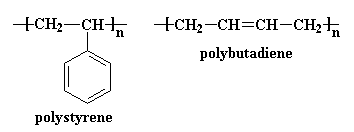

What Is and Immiscible Blend?
Morphology
Properties of Immiscible Blends
What Is an Immiscible Blend?
Long ago someone came up with the idea of taking two polymers and mixing
them together in order to get a material with properties somewhere between
those of the two polymers mixed. Materials made from two polymers mixed
together are called blends. But if you read the
blends page, you'll know that it's not very often that two polymers will
mix with each other. Most of the time, if you try to mix two kinds of
polymers, you'll end up with something that looks like chicken soup. Take
a look at a bowl of good chicken soup, and you'll see that it has two
phases: a water phase and a chicken fat phase. The chicken fat is
insoluble in water, so it forms little blobs in the soup separate form the
water phase. So we say mixtures like chicken soup are
phase-separated.
Phase-separated mixtures are just what you get when you try to mix most polymers. But strangely enough, the phase-separated materials often turn out to be rather nifty and useful. We even have a name for them. We call them immiscible blends. Ok, I have to admit, that name is an oxymoron. These materials aren't really blends; they can't be if they're immiscible, but that's the name people use.

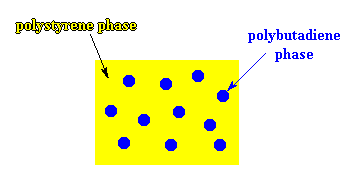
The little spheres of polybutadiene do a lot for the material. You see, polystyrene is a rather brittle material. It's stiff, but you can break it easily if you try to bend it. But those little polybutadiene spheres are rubbery, remember, and they can absorb energy under stress. This keeps the polystyrene from breaking. This immiscible blend has more ability to bend instead of breaking than regular polystyrene. That is, it's tougher and more ductile. Immiscible blends of polystyrene and polybutadiene are sold commercially under the name high-impact polystyrene, or HIPS for short.

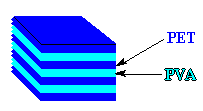 Another immiscible blend you may be familiar with is one made from a
polyester called poly(ethylene terephthalate) and
poly(vinyl alcohol). We call them PET and PVA, respectively, for short.
If you put just the right amounts of the two polymers together under the
right conditions you'll get something that looks like the picture on the
left, when you look at it under an electron microscope.
Another immiscible blend you may be familiar with is one made from a
polyester called poly(ethylene terephthalate) and
poly(vinyl alcohol). We call them PET and PVA, respectively, for short.
If you put just the right amounts of the two polymers together under the
right conditions you'll get something that looks like the picture on the
left, when you look at it under an electron microscope.
In this material, PET and PVA separate into sheetlike layers called lamellae. We call the resulting arrangement lamellar morphology. This particular immiscible blend is used to make plastic bottles for carbonated beverages. The PET makes the bottle strong, while the layers of PVA do something very important if you want your sodas to stay fizzy. Carbon dioxide can't pass through PVA. If the carbon dioxide in your soda leaked out (it can pass easily through plain PET), your soda would go flat.
We call the shape made by the two phases, and the arrangement of the two
phases morphology. The biggest thing one can do to affect the
morphology of an immiscible blend is to control the relative amounts of
the two polymers one is using. Let's say you're trying to make an
immiscible blend from two polymers, polymer A and polymer B. If you have
a lot more of polymer A than polymer B, polymer B separate into little
spherical globs. The spheres of polymer B will be separated from each
other by a sea of polymer A, like you see in the picture below. In such a
case we call polymer A the major component and polymer B the
minor component.
relative amount of polymer B in the immiscible blend
But if you put more polymer B into the immiscible blend, the spheres will
get bigger and bigger, until they get so big that they become joined
together. Now they aren't isolated spheres anymore, but a continuous
phase. The immiscible blend now looks like the middle picture above.
It might help to think of a block of colby-jack cheese. The domains of
polymer B are now joined together, but so are the domains of polymer A.
When this happens we say that the polymer A phase and the polymer B phase
are co-continuous.
But if we keep adding more polymer B, eventually there will be so much
more polymer B in the immiscible blend that polymer A will become
nothing but isolated spheres surrounded by a continuous phase of polymer
just like you see in the picture above on the right. Polymer B is now the
major component and polymer A is the minor component, and the situation is
reversed from what we had at first.
This is called biaxial stress, and it causes the domains of PET and
the domains of PVA to flatten out, just like pizza dough does when you
roll it. This is how we get flat layers instead of spheres in our
immiscible blend.
Another interesting morphology you can get is one of rod-like domains of
one polymer surrounded by a continuous phase of the other. This happens
when the immiscible blend is put under stress in only one direction, such
as during extrusion.
Ok, we have to talk about one last thing when we're talking about
morphology, and that is size. Let's go back to that simple case we talked
about earlier, where we had spheres of polymer B surrounded by continuous
phase of polymer A. How big are the spheres? How far apart are they?
Could you see them if you looked at a sample of an immiscible blend?
I hate to disappoint everyone, but in most cases you're not going to be
able to see the two separate phases with your own eyes. In fact, it
usually takes an electron microscope. So the phase domains, spherical or
otherwise, are very small.
But the domains do try to be as big as they can. Take our spheres for
example. The bigger the spheres are, the less surface area they will
have. A few bigger spheres have less surface area than a bunch of little
ones. The less surface area, the better. Remember, the two polymers in
an immiscible blend don't like each other, and the smaller the surface
area of the spheres, the less the two polymers have to touch each other.
I figure you're going to want some numbers, so I'll tell you some
specifics on an 80:20 immiscible blend of high density polyethylene and polystyrene. Polystyrene is the minor component
here, so it will form the separated spherical domains, and they tend to be
in the range of 5-10 mm in
diameter.1
One unusual property of immiscible blends is
that one made from two amorphous polymers has two glass transition temperatures or Tgs for short.
Since the two components are phase separated, the retain their separate
Tgs. In fact, scientists often measure the Tg of a blend to
find out if it is miscible or immiscible. If two Tgs are found,
then the blend is immiscible. If only one Tg is observed, then
the blend is likely to be miscible.
But what about mechanical properties? Let's consider an immiscible blend
of a major component polymer A and a minor component polymer B, whose
morphology is that of spheres of polymer B dispersed in a matrix of
polymer A. The mechanical properties of this immiscible blend are going
to depend on those of polymer A, because the polymer A phase is absorbing
all the stress and energy when the material is under load. In addition,
the immiscible blend is going to be weaker than a sample of pure polymer
A.
Another way to make a strong immiscible blend is to use more equal amounts
of the two polymers. Remember, when the relative amounts of the two
polymers are equal, we get a different morphology than when one is in
large excess. When polymer A and polymer B are present in roughly equal
amounts, they form two co-continuous phases. This means both phases will
be
bearing the load of any stress on the material, so it will be stronger.
But one of the most interesting ways to make immiscible blends stronger is
to use a compatibilizer. So what is a compatibilizer? A
compatibilizer is anything that helps bond the two phases to each other
more tightly. You see, in an immiscible blend, the two phases are not
bonded very strongly to each other. Remember, they don't like each other,
and that is why they are immiscible in the first place. But if stress and
energy are going to be transferred between the components, they have to be
bound to each other in some fashion.
The block copolymers tie the two phases together, and allow energy to be
transferred from one phase to the other. This means that the minor
component can improve the mechanical properties of the major component
rather than worsen them.
Graft copolymers are also used as compatibilizers. HIPS contains graft
copolymers of polystyrene grafted onto a polybutadiene backbone chain.
These graft copolymers allow stress to be transferred from the polystyrene
phase to the polybutadiene phase. Since polybutadiene is rubbery, it
dissipates the energy which would otherwise cause the brittle polystyrene
phase to break. This is why HIPS is tougher than regular polystyrene.
But a compatibilizer lowers the energy of the phase boundary, as we say.
What we mean is that the two phases can stand each other a little more
when there is a compatibilizer present. So the need to minimize contact
between the two phases isn't as great. So when a compatibilizer is used,
our spheres don't need to be as big. Remember our 80:20 immiscible blend
of high density polyethylene and polystyrene? The polystyrene spheres
were about 5-10 mm in diameter. When enough of
a polystyrene-polyethylene block copolymer (enough being 9%) is added to
the immiscible blend, the size of the polystyrene spheres drops to about 1
mm.1
This is good for the mechanical properties of the immiscible blend. The
smaller the spheres, the greater the area of the phase boundary between
the two phases, of course. The greater the area of the phase boundary,
the more efficiently energy can be transferred from one phase to the
other, meaning better mechanical properties.
1. Fayt, R., Hadjiandreou, P. and Teyssie, P., J. Polym. Sci. Polym.
Chem. Ed., 1985, 23, 337.
Morphology
I hope you folks are asking a question right now. Did you notice a
difference between the two immiscible blends we just talked about? Did
you notice that in HIPS, one polymer forms into little spheres dispersed
in the polystyrene? Did you also notice that in the PET-PVA system, the
two polymers separated into layers? Why are the two different? Why do
they separate in different fashions?


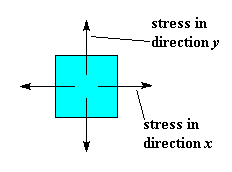 Spheres, co-continuity, then more spheres...so how do we get the neat
layers that you get in the PET-PVA immiscible blend? Sometimes the way in
which a product is processed affects the morphology of the material. soft
drink bottles are made by a technique called blow molding. To make
a bottle we take a small piece of plastic that looks like a test tube,
about 1 inch (2.5 cm) in diameter and maybe 6 inches (15 cm) long. We
heat the tube up, then inflate it like a balloon until it is the size we
want it. This whole procedure puts the material under stress. Think about
a section of the skin of the bottle. When it is being inflated, it is put
under stress in two directions, like you see in this picture on the right.
Spheres, co-continuity, then more spheres...so how do we get the neat
layers that you get in the PET-PVA immiscible blend? Sometimes the way in
which a product is processed affects the morphology of the material. soft
drink bottles are made by a technique called blow molding. To make
a bottle we take a small piece of plastic that looks like a test tube,
about 1 inch (2.5 cm) in diameter and maybe 6 inches (15 cm) long. We
heat the tube up, then inflate it like a balloon until it is the size we
want it. This whole procedure puts the material under stress. Think about
a section of the skin of the bottle. When it is being inflated, it is put
under stress in two directions, like you see in this picture on the right.

Processing under flow in one direction turns the spheres into rods.
Properties of Immiscible Blends
How do these immiscible blends behave? They have to behave in some
interesting manner, or else nobody would make them, and people like me
wouldn't write about them.
 So why make immiscible blends then, if separate materials are stronger?
It turn out there are some tricks one can do to make immiscible blends
strong. One is to process them under flow. If we process them under flow
in one direction, the minor component will form rods instead of spheres,
Like you see in the picture on your right. These rods act like the fibers of a reinforced composite material. They make the material
stronger in the direction of the rods.
So why make immiscible blends then, if separate materials are stronger?
It turn out there are some tricks one can do to make immiscible blends
strong. One is to process them under flow. If we process them under flow
in one direction, the minor component will form rods instead of spheres,
Like you see in the picture on your right. These rods act like the fibers of a reinforced composite material. They make the material
stronger in the direction of the rods.
 That's where compatibilizers come in. Often times a compatibilizer is a
block copolymer of the two components of the
immiscible blend. Let's take our example of an immiscible blend of
polymer A and polymer B again. Let's make polymer A the major component
and polymer B the minor component, and then let's throw in a block
copolymer of A and B. For those of you who may not no, a block copolymer
of A and B is a polymer with one long segment of polymer A joined to
another long segment of polymer B, like you can see on your right.
That's where compatibilizers come in. Often times a compatibilizer is a
block copolymer of the two components of the
immiscible blend. Let's take our example of an immiscible blend of
polymer A and polymer B again. Let's make polymer A the major component
and polymer B the minor component, and then let's throw in a block
copolymer of A and B. For those of you who may not no, a block copolymer
of A and B is a polymer with one long segment of polymer A joined to
another long segment of polymer B, like you can see on your right.
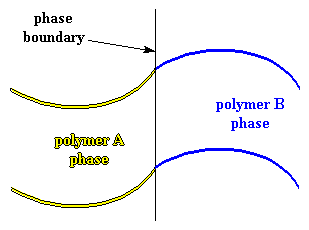 Of course, the A block is going to want to be in the polymer A phase, and
the B block is going to want to be in the polymer B phase. So the
copolymer molecule has to sit right on the phase boundary between the
polymer A and the polymer B phases. The A block can then be happy sitting
in the polymer A phase, and the B block is happy because it can stay in
the polymer B phase, as you can see in the picture on your left.
Of course, the A block is going to want to be in the polymer A phase, and
the B block is going to want to be in the polymer B phase. So the
copolymer molecule has to sit right on the phase boundary between the
polymer A and the polymer B phases. The A block can then be happy sitting
in the polymer A phase, and the B block is happy because it can stay in
the polymer B phase, as you can see in the picture on your left.
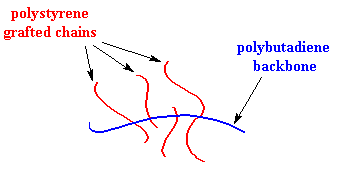
References

|
Return to Level Three Directory |

|
Return to Macrogalleria Directory |
